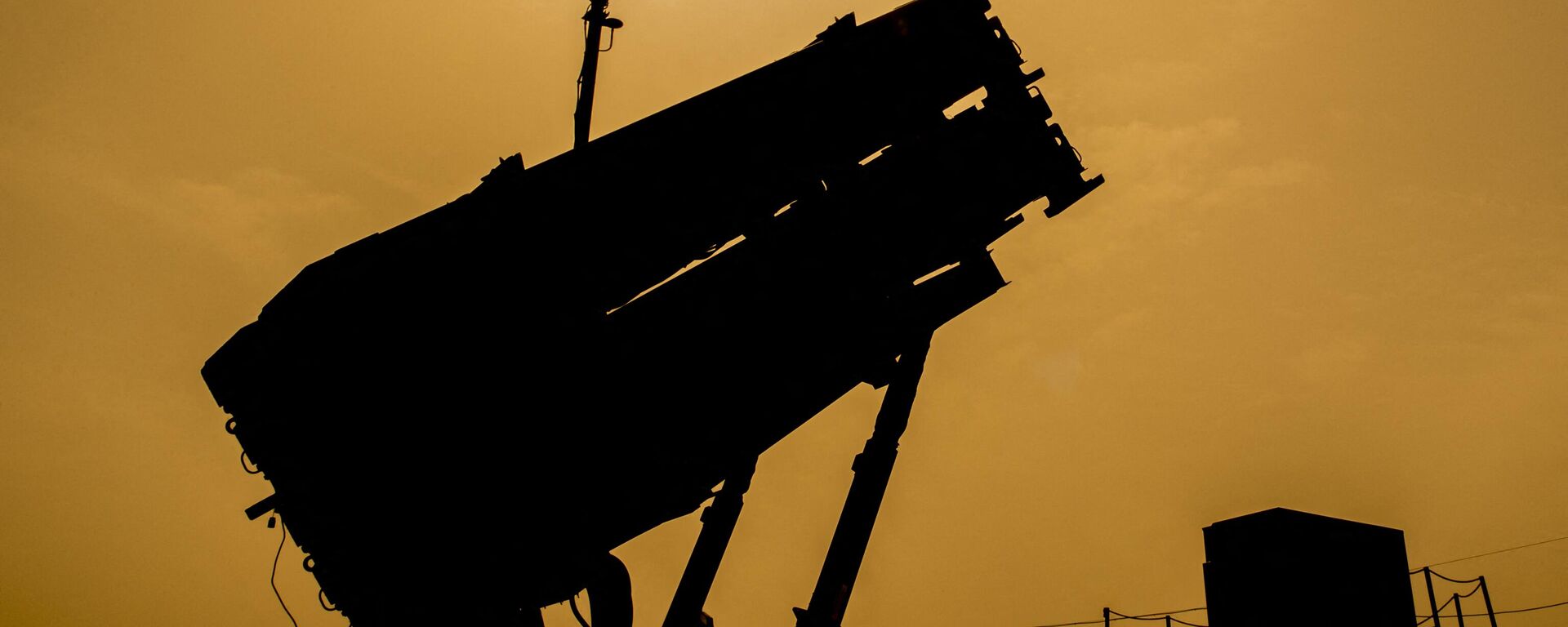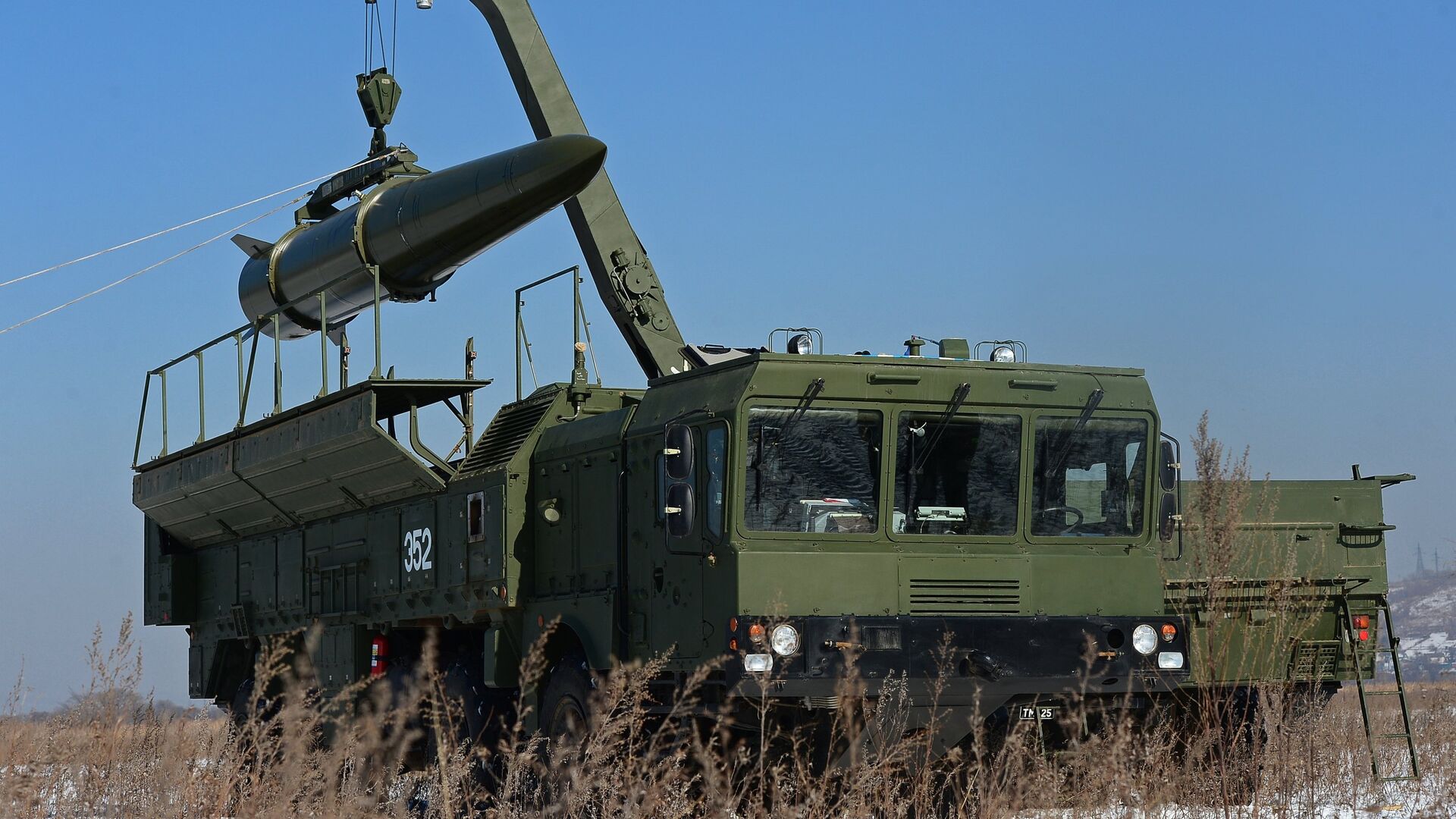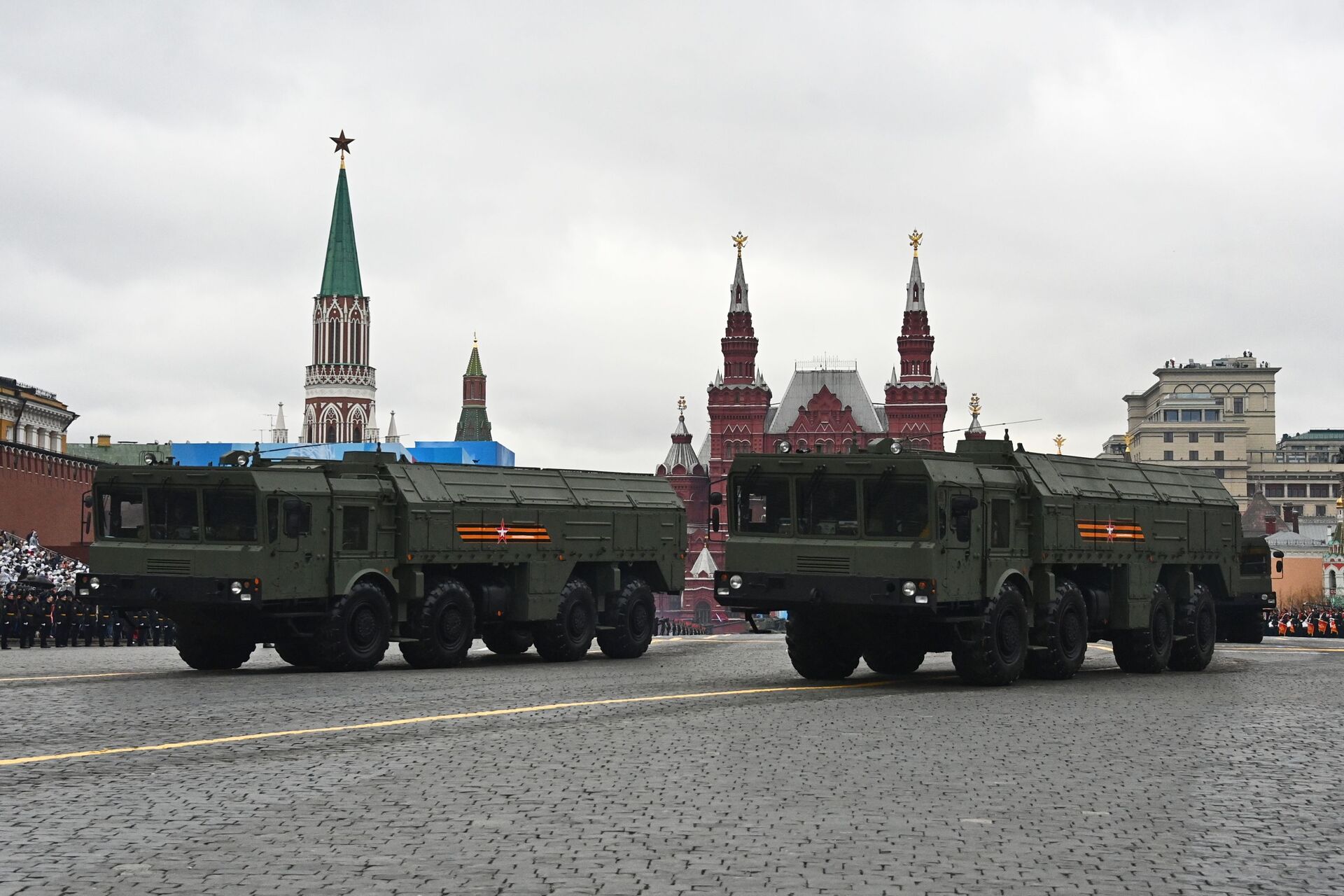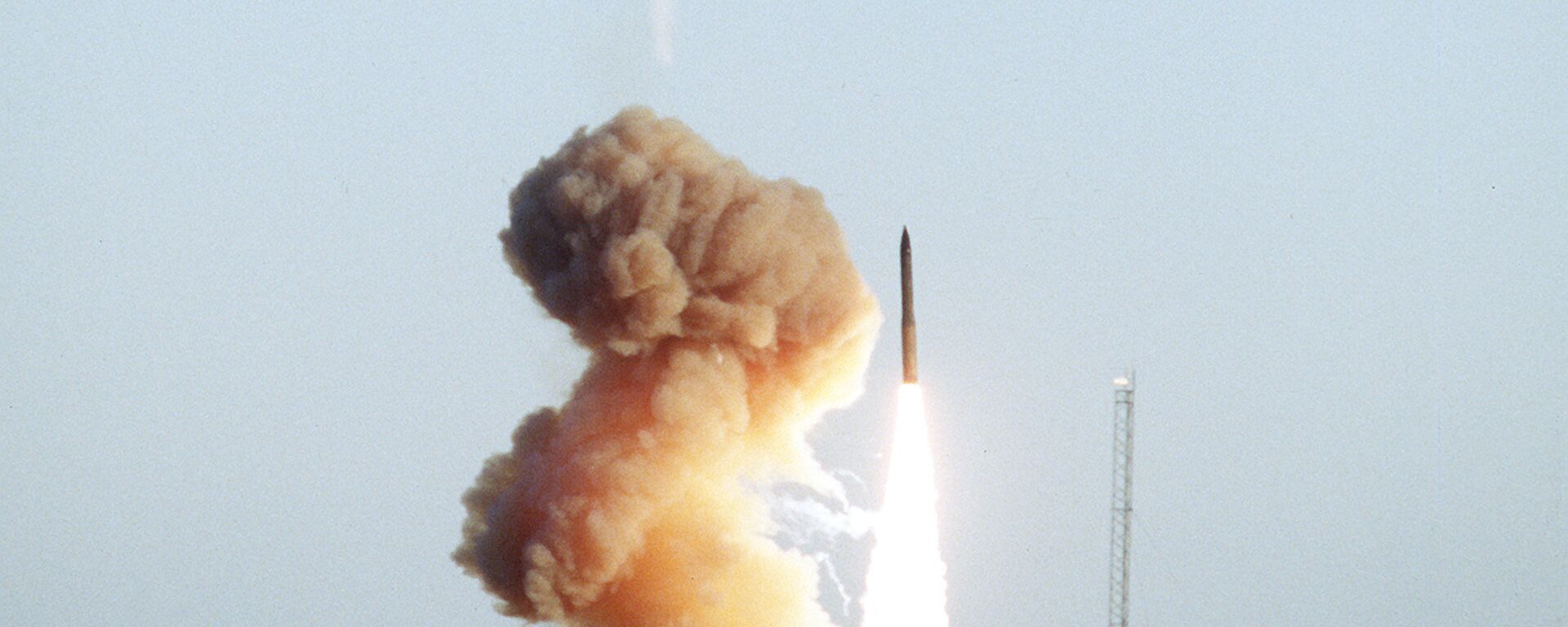https://sputnikglobe.com/20230403/inside-the-iskander-a-closer-look-at-russias-deadly-short-range-missile-1109080044.html
Inside the Iskander: A Closer Look at Russia's Deadly Short-Range Missile
Inside the Iskander: A Closer Look at Russia's Deadly Short-Range Missile
Sputnik International
Russia’s Missile Troops began training their Belarusian counterparts in the use of the Iskander missile system on Monday. An undisclosed number of the mobile, nuclear-capable short-range ballistic missile systems were sent to Belarus late last year. What is it about these weapons that’s driven NATO military planners up the wall? Sputnik explains.
2023-04-03T13:29+0000
2023-04-03T13:29+0000
2023-04-03T13:29+0000
analysis
iskander
iskander ballistic missile
iskander-m
iskander-m ballistic missile systems
iskander-e
iskander-k
missile
missile launcher
ballistic missile
https://cdn1.img.sputnikglobe.com/img/104778/76/1047787675_0:157:3083:1891_1920x0_80_0_0_9ea3bfe3dc77b8495cc4a5e077b69a7b.jpg
Russian President Vladimir Putin and his Belarusian counterpart Alexander Lukashenko have confirmed their agreement on the deployment of Russian tactical nuclear weapons in Belarus.“On April 3, we start training crews. On July 1, we will complete the construction of a special storage facility for tactical nuclear weapons on Belarusian territory,” Putin said in a television interview late last month. He added that Moscow has already handed Iskander missile systems to Minsk, and provided its ally with support to reequip combat aircraft to carry nuclear weapons.In an address last Friday, Lukashenko said that along with tactical nukes, Belarus would be prepared to consider hosting Russian strategic nuclear weapons if the security situation necessitated it. Lukashenko confirmed the receipt of the Iskanders, and the re-equipment of aircraft. “You’ve heard from the Russian president about our joint plan to create the necessary infrastructure on Belarusian territory. I would only like to clarify: all the infrastructure has been created and prepared,” he said. Lukashenko suggested that hopefully, the measures taken by Moscow and Minsk would strengthen the allies’ defense capability and “sober up the overseas hawks and their satellites.”NATO officials predictably attacked Russia and Putin over his “dangerous and irresponsible” “nuclear rhetoric,” while European Union foreign affairs chief Josep Borrell said Russian nukes in Belarus would pose a “threat to European security.”Russian media questioned the sincerity of NATO’s concerns, given that the US has placed more than a hundred nuclear weapons in half-a-dozen European nations – and not just tactical nukes, but B61 bombs with a blast yield of up to 340 kilotons. (The atomic bombs dropped on Hiroshima and Nagasaki, which killed up to 215,000 people, had a kilotonnage of 15 and 25 kilotons, respectively.)What is the Iskander Missile System?The weapon at the heart of discussions about nukes in Belarus is the Iskander, a Soviet and Russian designed short-range missile system whose development began in the late 1980s. The system was created out of the need to create a new road mobile, nuclear-capable missile system which would be in line with the provisions of the Intermediate-Range Nuclear Forces Treaty (INF Treaty), which banned ground-based nuclear missile systems in the 500-5,500 km range. The Iskander derives its name from Alexander the Great, the 4th century BC Macedonian king who is known in the nations of the Caucuses and Central Asia as Iskander.The first Iskanders were adopted into service with the Russian military in the mid-2000s. The system was developed by engineers at the KB Mashinostroyeniya, a Moscow region defense concern. Its missiles and ground equipment are manufactured by defense companies in Udmurtia and Volgograd.How Powerful is the Iskander Missile System, and is it Nuclear?Each Iskander launcher is capable of carrying two missiles which can be armed with a wide variety of conventional and nuclear weaponry, ranging from bunker-busting munitions and air-burst cluster fragmentation warheads to high-explosive fragmentation warheads and electromagnetic pulse (EMP) rounds. Warheads weigh between 480 and 700 kg. The system’s nuclear warhead variant has a throw weight of up to 50 kilotons – classifying it a tactical nuke. The Iskander also has a cruise missile variant known as the Iskander-K. In an announcement on Russian plans to transfer Iskanders to Belarus last year, Russian President Vladimir Putin confirmed that the delivered systems would be able to fire both “ballistic and cruise missiles,” and both conventional and nuclear rounds.How Accurate is the Iskander, and How Far Can It Reach?The Iskander missile system has a circular error probable (CEP) rating of between 30 and 70 meters, or 5-7 meters when equipped with a homing system. The system has a minimum range of 50 km, and a maximum range of up to 500 km. If deployed in northern, western or southern Belarus, Iskanders would be able to reach the Baltics, most of Poland, and most of northern Ukraine, respectively.In the wake of the US decision to rip up the INF Treaty in 2019, Russia may lift its self-imposed restrictions on the Iskander’s flight range, and develop new ballistic or cruise missiles which would extend its reach by hundreds or even thousands of kilometers.How Many Iskander Missiles Does Russia Have?Russia’s arsenal of Iskander missile systems consists of 162 or more firing platforms, 150 of them in the ground forces, and 12 among the Navy’s coastal defense troops. The number of missiles of various modifications is kept under wraps, but is thought to be in the hundreds.How Much Do Iskander Missiles Cost?For obvious reasons, Russia doesn’t advertise the cost of its Iskander missiles or launch platforms. Western and Ukrainian media have estimated the cost of an individual rocket at about $3 million, but have not provided compelling evidence to back up this approximation, with the estimate possibly a propaganda ploy designed to exaggerate the cost of Russia’s military operation in Ukraine.Can NATO Air and Missile Defenses Like the Patriot and THAAD Stop Iskander?During flight, Iskander missiles accelerate to speeds of up to Mach 7 (2.6 km per second), climb to altitudes between 6 and 50 km, and maneuver in flight to avoid enemy air defenses. The Iskander-K cruise variant engages in evasive maneuvers and flies low to the ground to avoid radar detection and allow them to get the drop on adversaries. US missile defense systems including Patriots and the Terminal High Altittude Area Defense (THAAD) missiles are designed to intercept ballistic and cruise missiles, including the Iskander, but this has yet to be tried in practice.The US announced plans to deliver Patriot missile batteries to Ukraine late last year, but the system’s less than stellar performance against Saddam Hussein’s Iraq, and even against Yemen’s Houthi warriors, has raised questions about how the Patriot will perform against a near peer or peer adversary like Russia. That makes the Biden administration’s Patriot delivery announcement highly risky.Does Iskander Deployment in Belarus Mean Russia is Preparing to Use Nukes in Ukraine?No. Russia’s nuclear doctrine expressly forbids the use of nuclear weapons, including tactical nukes, barring an existential threat to the country’s national security. Russia’s nuclear doctrine, published by the Foreign Ministry in June 2020, deems nuclear weapons of any kind “exclusively a means of deterrence” whose use would be considered only as an “extreme and compelled measure” in response to the enemy use of weapons of mass destruction against Russia or its allies, or a conventional attack so severe that the “very existence of the state” is deemed to be jeopardized. President Putin has hinted at the need to revise the nuclear doctrine to allow for preventative nuclear strikes – which would bring the doctrine closer to that of the Pentagon, but this proposal has yet to be laid down in writing.Do Iskander Missiles Pose Threat to Europe?No more so than the creeping deployment of NATO infrastructure near Russia’s borders, the storage of American nuclear bombs in European countries and Turkiye, or the construction of nuclear cruise-missile capable anti-missile systems in Poland and Romania.Before the escalation of the Ukrainian crisis, Moscow repeatedly expressed its concerns to the US and NATO about the deployment of alliance nuclear and missile infrastructure near Russia, citing the short flight time of such weapons in the event of a conflict (measured in minutes). Growing discussion about the deployment of nuclear weapons in Europe echoes the security situation in Europe in the mid-1980s, when the US and the USSR had thousands of nuclear weapons pointed at one another. The key difference is that today, the standoff between the nuclear superpowers is taking place not in the heart of Central Europe, but right next to Russia’s borders.
https://sputnikglobe.com/20230327/does-the-us-have-any-nuclear-weapons-in-europe-1108820891.html
https://sputnikglobe.com/20221119/all-missile-forces-re-equipped-with-iskander-m-missile-systems-russian-mod-says-1104420395.html
https://sputnikglobe.com/20230117/pentagon-ukrainian-troops-officially-begin-patriot-missile-training-at-us-military-base-1106438825.html
https://sputnikglobe.com/20221105/nato-not-planning-to-change-its-nuclear-deployments-stoltenberg-says--1103820829.html
Sputnik International
feedback@sputniknews.com
+74956456601
MIA „Rossiya Segodnya“
2023
News
en_EN
Sputnik International
feedback@sputniknews.com
+74956456601
MIA „Rossiya Segodnya“
Sputnik International
feedback@sputniknews.com
+74956456601
MIA „Rossiya Segodnya“
iskander, missile system, missiles, ballistic missiles, cruise missiles, what is the iskander missile system, how powerful is the iskander missile system, is the iskander missile system nuclear, how accurate is the iskander missile system, how far can iskander missiles reach, how many iskander missiles does russia have, how much do iskander missiles cost, can patriot missiles and thaad stop iskander, does russia plan to use nukes in ukraine, do iskander missiles pose a threat to europe
iskander, missile system, missiles, ballistic missiles, cruise missiles, what is the iskander missile system, how powerful is the iskander missile system, is the iskander missile system nuclear, how accurate is the iskander missile system, how far can iskander missiles reach, how many iskander missiles does russia have, how much do iskander missiles cost, can patriot missiles and thaad stop iskander, does russia plan to use nukes in ukraine, do iskander missiles pose a threat to europe
Inside the Iskander: A Closer Look at Russia's Deadly Short-Range Missile
Russia’s Missile Troops began training their Belarusian counterparts in the use of the Iskander missile system on Monday. An undisclosed number of the mobile, nuclear-capable short-range ballistic missile systems were sent to Belarus late last year. What is it about these weapons that’s driven NATO military planners up the wall? Sputnik explains.
Russian President Vladimir Putin and his Belarusian counterpart Alexander Lukashenko have confirmed their agreement on the deployment of Russian tactical nuclear weapons in Belarus.
“On April 3, we start training crews. On July 1, we will complete the construction of a special storage facility for tactical nuclear weapons on Belarusian territory,” Putin said in a television interview late last month. He added that Moscow has already handed Iskander missile systems to Minsk, and provided its ally with support to reequip combat aircraft to carry nuclear weapons.
In an address last Friday, Lukashenko said that along with tactical nukes, Belarus would be prepared to consider hosting Russian strategic nuclear weapons if the security situation necessitated it. Lukashenko confirmed the receipt of the Iskanders, and the re-equipment of aircraft. “You’ve heard from the Russian president about our joint plan to create the necessary infrastructure on Belarusian territory. I would only like to clarify: all the infrastructure has been created and prepared,” he said. Lukashenko suggested that hopefully, the measures taken by Moscow and Minsk would strengthen the allies’ defense capability and “sober up the overseas hawks and their satellites.”
NATO officials predictably attacked Russia and Putin over his
“dangerous and irresponsible” “nuclear rhetoric,” while European Union foreign affairs chief Josep Borrell
said Russian nukes in Belarus would pose a “threat to European security.”
The Belarusian Foreign Ministry countered, saying that the real “irresponsible escalation” and threat to European security lay in the “deployment of fresh NATO troops near the Belarusian border and the alliance’s further enlargement in Northern Europe.”
Russian media questioned the sincerity of NATO’s concerns, given that the US has placed more than a hundred nuclear weapons in half-a-dozen European nations – and not just tactical nukes, but
B61 bombs with a blast yield of up to 340 kilotons. (The atomic bombs dropped on Hiroshima and Nagasaki, which killed up to 215,000 people, had a kilotonnage of 15 and 25 kilotons, respectively.)
What is the Iskander Missile System?
The weapon at the heart of discussions about nukes in Belarus is the Iskander, a Soviet and Russian designed short-range missile system whose development began in the late 1980s. The system was created out of the need to create a new road mobile, nuclear-capable missile system which would be in line with the provisions of the Intermediate-Range Nuclear Forces Treaty (INF Treaty), which banned ground-based nuclear missile systems in the 500-5,500 km range. The Iskander derives its name from Alexander the Great, the 4th century BC Macedonian king who is known in the nations of the Caucuses and Central Asia as Iskander.
The first Iskanders were adopted into service with the Russian military in the mid-2000s. The system was developed by engineers at the KB Mashinostroyeniya, a Moscow region defense concern. Its missiles and ground equipment are manufactured by defense companies in Udmurtia and Volgograd.
How Powerful is the Iskander Missile System, and is it Nuclear?
Each Iskander launcher is capable of carrying two missiles which can be armed with a wide variety of conventional and nuclear weaponry, ranging from bunker-busting munitions and air-burst cluster fragmentation warheads to high-explosive fragmentation warheads and electromagnetic pulse (EMP) rounds. Warheads weigh between 480 and 700 kg. The system’s nuclear warhead variant has a throw weight of up to 50 kilotons – classifying it a tactical nuke. The Iskander also has a cruise missile variant known as the Iskander-K. In an announcement on Russian plans to transfer Iskanders to Belarus last year, Russian President Vladimir Putin confirmed that the delivered systems would be able to fire both “ballistic and cruise missiles,” and both conventional and nuclear rounds.
How Accurate is the Iskander, and How Far Can It Reach?
The Iskander missile system has a circular error probable (CEP) rating of between 30 and 70 meters, or 5-7 meters when equipped with a homing system. The system has a minimum range of 50 km, and a maximum range of up to 500 km. If deployed in northern, western or southern Belarus, Iskanders would be able to reach the Baltics, most of Poland, and most of northern Ukraine, respectively.
In the wake of the US decision to rip up the INF Treaty in 2019, Russia may lift its self-imposed restrictions on the Iskander’s flight range, and develop new ballistic or cruise missiles which would extend its reach by hundreds or even thousands of kilometers.

19 November 2022, 06:49 GMT
How Many Iskander Missiles Does Russia Have?
Russia’s arsenal of Iskander missile systems consists of 162 or more firing platforms, 150 of them in the ground forces, and 12 among the Navy’s coastal defense troops. The number of missiles of various modifications is kept under wraps, but is thought to be in the hundreds.
How Much Do Iskander Missiles Cost?
For obvious reasons, Russia doesn’t advertise the cost of its Iskander missiles or launch platforms. Western and Ukrainian media have estimated the cost of an individual rocket at about
$3 million, but have not provided compelling evidence to back up this approximation, with the estimate possibly a propaganda ploy designed to exaggerate the cost of Russia’s military operation in Ukraine.
Can NATO Air and Missile Defenses Like the Patriot and THAAD Stop Iskander?
During flight, Iskander missiles accelerate to speeds of up to Mach 7 (2.6 km per second), climb to altitudes between 6 and 50 km, and maneuver in flight to avoid enemy air defenses. The Iskander-K cruise variant engages in evasive maneuvers and flies low to the ground to avoid radar detection and allow them to get the drop on adversaries. US missile defense systems including Patriots and the Terminal High Altittude Area Defense (THAAD) missiles are designed to intercept ballistic and cruise missiles, including the Iskander, but this has yet to be tried in practice.
The US
announced plans to deliver Patriot missile batteries to Ukraine late last year, but the system’s less than stellar performance against Saddam Hussein’s Iraq, and even against Yemen’s Houthi warriors, has
raised questions about how the Patriot will perform against a near peer or peer adversary like Russia. That makes the Biden administration’s Patriot delivery announcement highly risky.

17 January 2023, 20:24 GMT
Does Iskander Deployment in Belarus Mean Russia is Preparing to Use Nukes in Ukraine?
No. Russia’s nuclear doctrine expressly forbids the use of nuclear weapons, including tactical nukes, barring an existential threat to the country’s national security. Russia’s nuclear doctrine,
published by the Foreign Ministry in June 2020, deems nuclear weapons of any kind “exclusively a means of deterrence” whose use would be considered only as an “extreme and compelled measure” in response to the enemy use of weapons of mass destruction against Russia or its allies, or a conventional attack so severe that the “very existence of the state” is deemed to be jeopardized. President Putin has hinted at the need to revise the nuclear doctrine to allow for preventative nuclear strikes – which would bring the doctrine closer to that of the Pentagon, but this proposal has yet to be laid down in writing.
Do Iskander Missiles Pose Threat to Europe?
No more so than the creeping deployment of NATO infrastructure near Russia’s borders, the storage of American nuclear bombs in European countries and Turkiye, or the construction of nuclear cruise-missile capable anti-missile systems in Poland and Romania.
Before the escalation of the Ukrainian crisis, Moscow repeatedly expressed its concerns to the US and NATO about the deployment of alliance nuclear and missile infrastructure near Russia, citing the short flight time of such weapons in the event of a conflict (measured in minutes). Growing discussion about the deployment of nuclear weapons in Europe echoes the security situation in Europe in the mid-1980s, when the US and the USSR had thousands of nuclear weapons pointed at one another. The key difference is that today, the standoff between the nuclear superpowers is taking place not in the heart of Central Europe, but right next to Russia’s borders.

5 November 2022, 16:51 GMT







